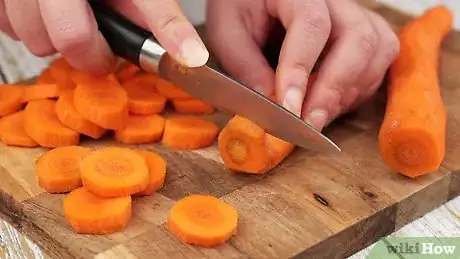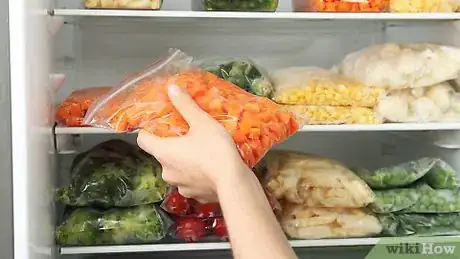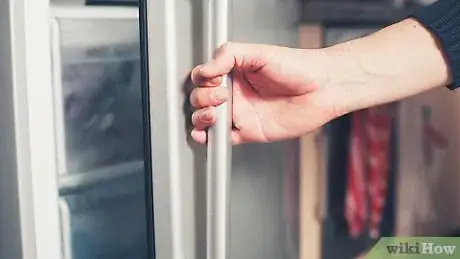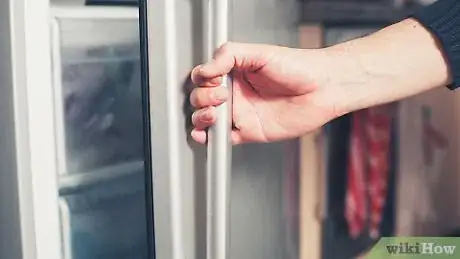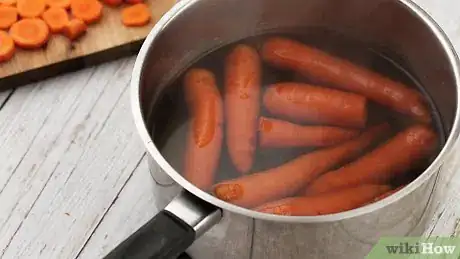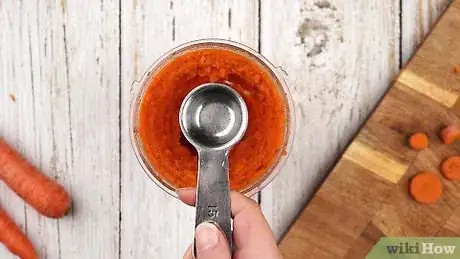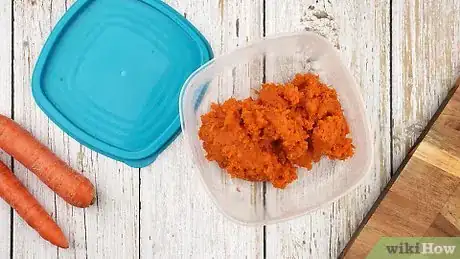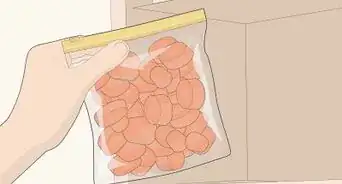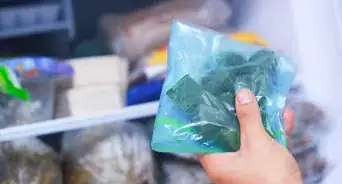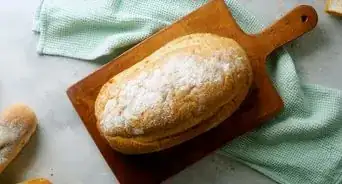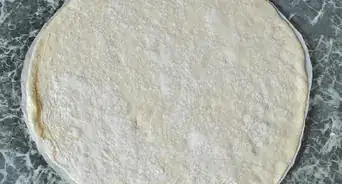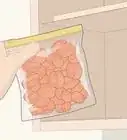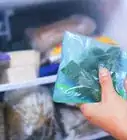This article was co-authored by Jennifer Levasseur. Chef Jennifer Levasseur is a Personal Chef and the Owner of The Happy Cuisiniere based in Breckenridge, Colorado. She has over 12 years of culinary experience and specializes in Mountain and Contemporary Rustic cuisine. Moreover, she can craft dishes and modify menus to accommodate dietary restrictions, such as gluten-free, vegetarian, vegan, pescatarian, and dairy-free diets. In addition to a Bachelor’s degree in Marketing and Management from the University of Houston, Chef Jennifer holds Associate’s degrees in Culinary Arts and Baking & Pastry Arts from Houston Community College.
There are 11 references cited in this article, which can be found at the bottom of the page.
This article has been viewed 51,118 times.
Although blanching is an excellent way to preserve a carrot's flavor before storing, it can be a time-consuming process. If you'd prefer not to blanch your carrots, you can freeze unblanched carrots for up to 10 months at a time. Depending on your preferences, you can store unblanched carrots by chopping, shredding, or pureeing them beforehand. Once you've sufficiently prepared them, your unblanched carrots will stay frozen and well-preserved until you're ready to use them!
Steps
Freezing Chopped Carrots
-
1Chop the carrot into 1⁄4–1⁄2 in (0.64–1.27 cm) pieces. Peel the carrot with a knife and cut off the tips about 1⁄2 in (1.3 cm) out on each side. Cut the carrot into circles about 1⁄4–1⁄2 in (0.64–1.27 cm) wide for easier storage convenience and preservation.[1]
- You can freeze carrots whole and unpeeled as well. Just chop off the greens on top. However, your carrots may stay fresher cut into small pieces.
- If you notice any residual dirt on the carrots, wash it away over a sink before chopping.
-
2Place the chopped carrots in a sealable bag or airtight container. Fill a sealable plastic bag or airtight container with carrots and place a straw in the middle. If possible, fill the bag or container to 1–2 in (2.5–5.1 cm) below the top to allow for expansion. Suck out as much air as possible with the straw and, after taking the straw out, seal the container shut.
- The less air left inside the container, the more preserved they'll stay while frozen.
- Using a vacuum sealer to close the bags is an alternate, equally efficient way to preserve your carrots.
Advertisement -
3Set the carrots in the freezer on a flat surface. Mark the container with the date so you know how long it's been since you sealed them. Place the carrots on a flat surface in your freezer, preferably near the back, and leave them inside until you're ready to use them.[2]
- Avoid taking the carrots out until you cook them, as freezing and refreezing vegetables can diminish their flavor over time.
-
4Keep the carrots in the freezer for up to 10-12 months. Although frozen, unblanched carrots can stay preserved for 10-12 months, their taste and texture may change over time. If possible, try to use the carrots within 1-2 months for the best flavor.[3]
- Frozen carrots, blanched and unblanched, can last longer than 10-12 months but are more likely to develop freezer burn.
Freezing Shredded Carrots
-
1Wash the carrot over your sink before cutting. Place the carrot over your sink and turn on the water. Use your hands to rub off any dirt, particularly if your carrots came from your garden.[4]
- Unlike chopping carrots, you do not have to peel them beforehand.
-
2Remove the carrot's top and bottom. Using a knife, cut off both tips from your carrot about 1⁄2 in (1.3 cm) out. Discard the top and bottom after cutting them off, as you will not need to shred them with the rest of your carrot.[5]
-
3Shred the carrots with a food processor. Chop the carrots into 1⁄4–1⁄2 in (0.64–1.27 cm) wide circles and place them in a food processor. Turn the food processor on and blend until all of the carrot pieces are shredded.[6]
- If your blender has a food processor setting, you can use it as an alternative.
- You can also hand grate the carrots as an alternative by positioning a carrot at the top of the grater and repeatedly moving it down the side until you completely shred it.[7]
-
4Place the shredded carrots in an airtight, sealable bag. Fill the bag to about 1–2 in (2.5–5.1 cm) below the top to allow for expansion as the carrots freeze. Flatten the bag as much as you can with your hands, then roll the rest of the air out with a rolling pin. When you've finished flattening out the air, set the bag in the freezer until you're ready to thaw them.[8]
- Mark the container with the date and time so you know when it expires.
-
5Freeze the shredded, unblanched carrots for up to several months at a time. Frozen shredded carrots keep for about 10-12 months before losing flavor. For the best texture, however, try to use the carrots within several months of shredding and freezing them.
Freezing Carrot Puree
-
1Steam, microwave, boil, or bake your carrots. Carrots blend best after they've been softened through cooking. Cook your carrots to help them blend easier as you puree them.[9]
- Pureeing carrots before freezing preserves their taste best and is ideal for making soups, baked goods, and baby food.
- Let the cooked carrots cool before pureeing them in the blender.
-
2Puree the carrots with a blender. Chop the carrots into 1⁄4–1⁄2 in (0.64–1.27 cm) wide circles and place them in the blender. Turn your blender on, preferably to a "puree" setting, to mash the carrots into a paste with a thick consistency.[10]
- Never put fingers or utensils in the blender while it's still running.
-
3Add milk or water to the puree for a thinner consistency. Turn off the blender after pureeing and check the puree's texture. If it's too thick for your preferences, add small amounts of milk or water (1-2 tablespoons at a time) and blend again until you reach the desired consistency.[11]
- If you want a thick puree, blend the carrots without adding any liquids.
- To preserve the carrots' overall taste, add the water you used to boil or steam the carrots.[12]
-
4Pour the puree into a freezer-safe container. Once you've reached the desired consistency, grab a freezer-safe container that seals tightly. Pour the puree into the container (leaving about 1–2 in (2.5–5.1 cm) for expansion), put the lid on top, and set it in the freezer.
- Mark the container with the date so you know when you packaged it and when it will expire.
- If you place the puree in a glass container, make sure the container is specifically manufactured for freezing. Regular glass containers can crack or burst in extreme temperatures.[13]
-
5Store the puree in the freezer for up to 3 months. Carrot puree retains its flavor and consistency for up to 3 months before becoming at-risk for freezer burn. If you notice your puree's expiration day coming up, use it as soon as possible to prevent it from spoiling.[14]
- After thawing, carrot puree can stay in the fridge for 2-3 days without spoiling.
Warnings
- Although safe, freezing carrots without blanching can change their taste and texture. For a more natural taste, blanch your carrots before freezing instead.[17]⧼thumbs_response⧽
References
- ↑ https://www.seriouseats.com/2010/05/knife-skills-how-to-cut-carrots.html
- ↑ https://www.motherearthnews.com/real-food/freezing/freezing-vegetables-zebz1309zstp
- ↑ http://www.stilltasty.com/fooditems/index/16704
- ↑ https://northernhomestead.com/a-great-way-to-freeze-carrots/
- ↑ https://northernhomestead.com/a-great-way-to-freeze-carrots/
- ↑ https://northernhomestead.com/a-great-way-to-freeze-carrots/
- ↑ https://cnz.to/tips-tricks/grated-carrots-three-ways/
- ↑ https://northernhomestead.com/a-great-way-to-freeze-carrots/
- ↑ http://wholesomebabyfood.momtastic.com/pureebabyfoodandstore.htm
- ↑ https://www.thekitchn.com/why-carrot-puree-isnt-just-for-babies-212802
- ↑ http://wholesomebabyfood.momtastic.com/pureebabyfoodandstore.htm
- ↑ https://www.thekitchn.com/why-carrot-puree-isnt-just-for-babies-212802
- ↑ http://wholesomebabyfood.momtastic.com/freezepage.htm
- ↑ https://www.parents.com/recipes/baby-food/how-to-make-carrot-puree/
- ↑ https://www.eatbydate.com/vegetables/fresh-vegetables/how-long-do-carrots-last-shelf-life/
- ↑ https://www.motherearthnews.com/real-food/freezing/freezing-vegetables-zebz1309zstp
- ↑ http://www.carrotmuseum.co.uk/carrotstorage.html
